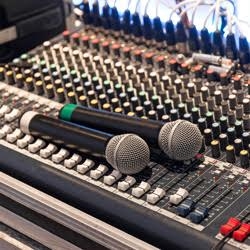
Licensed Wireless
In recognition of the widespread and essential use of wireless mics in event production, and pushed by the lobbying efforts of wireless manufacturers and other industry leaders, the FCC in 2013 broadened the types of users who are able to obtain licenses to encompass sound companies, live theatre, churches, and many other entities – going beyond the original categories of broadcasters and film production.
Larger users who typically occupy 50 or more channels will be able to obtain a Part 74 license, which will give them priority to use the RF spectrum at specific times and locations. This means that unlicensed users of white space devices or other wireless mics in those particular frequency bands will have to turn them off if they’re causing interference.
Ciaudelli points out that the FCC has made a clear distinction between unlicensed and licensed users, defined as those who routinely operate 50 or more channels.
“There are many entities who are eligible to become licensed operators, but they haven’t so far because functionally it wasn’t a necessity. Going forward, licensing will be vital,” he says, adding that, “It’s very important now to determine whether you’re eligible, and begin the licensing process. It provides rights and privileges over unlicensed operation of any device – not only other wireless mic users. You want to make sure that you’re higher on the totem pole.”
Additionally, licensed operators will be allowed the use of alternative bands outside of the traditional UHF, VHF, and ISM spectrum.
Spectrum Options
While pro audio is losing some UHF channels, other prime portions of spectrum are now open to licensed wireless microphone operators. For example, the mid-900 MHz band that was previously available only to broadcasters has been expanded from its previous 8 MHz bandwidth to almost 19 MHz. This 941 to 960 MHz spectrum provides another option for those who have been operating in the 600 MHz band, especially if they’ve already used up all the space available to them in the 500 MHz band.
The technology to use this newly opened spectrum is already in development and is very likely to come to market soon. And note that this additional bandwidth is in addition to the current unlicensed 902 to 928 MHz swath, with some professional systems, such as the Shure ULX-D, already operating in this range.
“Power users” at mega-events such as political conventions and sporting events will also be able to use 1.435 to 1.525 GHz. However, they will need to coordinate with a government agency called AFTrack because that frequency range is used for flight testing, typically Monday through Friday during daylight hours. The product development process to operate in this range incorporates some completely new technology, so it’s likely to be a few years before we see commercially available systems.
A new and critical component required to operate in this band is that equipment will need an electronic key to function. Users will be required to apply with AFTrack for the specific events where their wireless mics are to be used and will be given a code to enter into the equipment that allows it to operate at the specified time, date, and location.
New Technologies
As noted, manufacturers are adding new products and technologies to accommodate the transition. The Lectrosonics IFB4-VHF system offers 239 selectable frequencies between 174 and 216 MHz. In addition, the tuning ranges of the Venue 2 and SRc modular wireless receivers have been tripled to 75 MHz, and additional filtering technology has been added to reduce interference when multi-channel systems are used in a crowded RF environment. The company is also beginning development on equipment for the new frequency bands opened by the FCC for licensed users.
Audio-Technica is exploring other frequency bands as well as adding new products in the lower part of the UHF band, along with incorporating a variety of innovations into its wireless for non-licensed frequencies. Jim Lappin, product manager for wireless microphones at A-T, points to the System 10 PRO, which operates at 2.4 GHz while incorporating frequency and time diversity technologies, the ability to place modular receivers remotely via Cat cable, and linking technology that allows up to 10 receivers to be synched for simultaneous use.
In addition, A-T recently announced the formation of a new subsidiary company, Alteros, with a dedicated focus on providing a range of solutions to directly address the issues surrounding the ever-shrinking frequency spectrum by capitalizing on many years of ultra-wideband (UWB) and RF technology research, The new company is under the direction of president/CTO Jackie Green, U.S. VP of R&D/Engineering at A-T, who led the first commercial sound implementation of UWB technology with the SpectraPulse wireless microphone system that bypasses the increasingly congested RF environment. The Alteros management team also includes Brian Fair, executive VP of Digital Engineering, and Bob Green, executive VP of Product Engineering.
